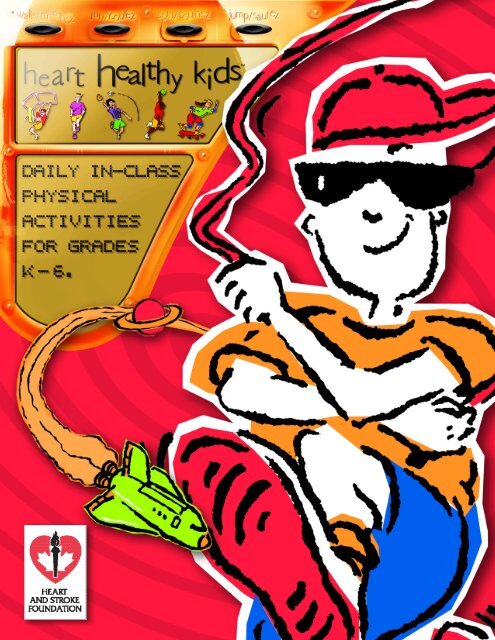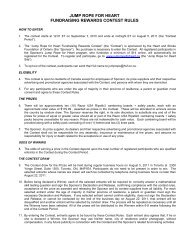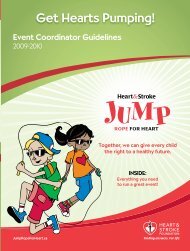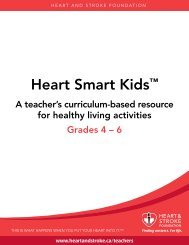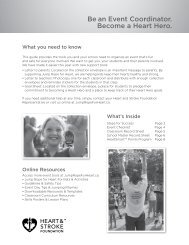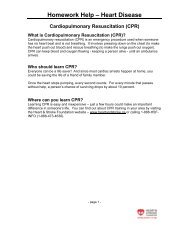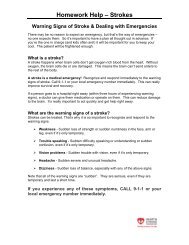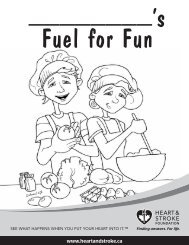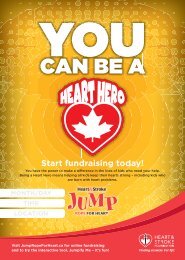Heart Healthy Kids Physical Activity Handbook - Jump Rope For Heart
Heart Healthy Kids Physical Activity Handbook - Jump Rope For Heart
Heart Healthy Kids Physical Activity Handbook - Jump Rope For Heart
Create successful ePaper yourself
Turn your PDF publications into a flip-book with our unique Google optimized e-Paper software.
Welcome to <strong>Heart</strong> <strong>Healthy</strong> <strong>Kids</strong> !<br />
This program has been created to help elementary teachers<br />
like you incorporate physical activity for your students into your<br />
daily classroom schedule. <strong>Activity</strong> habits developed early in life<br />
can carry over into adulthood and this program places emphasis<br />
on reducing inactivity and increasing daily participation in moderate<br />
physical activity.<br />
Recent re s e a rch has shown that health is improved by<br />
engaging in as little as 20 to 30 minutes of moderate physical<br />
activity 3 to 4 times per week. <strong>For</strong> youngsters, this can be achieved<br />
by accumulating the re q u i red amount of activity t h rough two,<br />
10 minute bouts of moderate physical activity enjoyed on a daily<br />
basis. This program’s goal is to engage students in a variety of<br />
activities each day in order to raise heart rates and impro v e<br />
health. And the best part of all is that these activities can be<br />
easily incorporated to achieve the expectations set out in the<br />
Ontario Ministry of Education Curriculum.<br />
Included in this package are manuals for all the<br />
teachers in your school plus one training video to provide a<br />
visual understanding of the activities. Please share and circ u l a t e<br />
the video to all of the teachers at your school but use the manuals<br />
to guide your activities on a day to day basis (if re q u i red, the<br />
manual may be photocopied). In order to help this program run<br />
as smoothly as possible, templates of all the charts etc. that you<br />
will need have been included in the manual.<br />
We hope that you enjoy using this program and are excited<br />
to get started.<br />
Table of Contents<br />
<strong>Heart</strong> <strong>Healthy</strong> <strong>Kids</strong> <br />
O v e r v i e w 3<br />
Key Features of<br />
<strong>Heart</strong> <strong>Healthy</strong> <strong>Kids</strong> 3<br />
The Te a c h i n g /<br />
Learning Progression 4<br />
Warm Up and<br />
Cool Down Routines 5<br />
M o n d a y A c t i v i t y-<br />
Word Power 6<br />
Word Power Template<br />
and Word Lists 7<br />
Tu e s d a yA c t i v i t y -<br />
Just Map It! 9<br />
Just Map It! Templates 1 0<br />
We d n e s d a yA c t i v i t y-<br />
C a r d i o F u n k 1 1<br />
Cardio Funk Routine 1 2<br />
T h u r s d a y A c t i v i t y -<br />
D e s k e r c i s e 1 3<br />
Deskercise Te m p l a t e s 14<br />
F r i d a y A c t i v i t y -<br />
Stop and Go 1 5<br />
Stop and Go <strong>Activity</strong> cards 1 6<br />
C o m p a n i o n<br />
Discussion Wo r k s h e e t s 2 1<br />
Feedback We l c o m e 2 6
H e a rt <strong>Healthy</strong> <strong>Kids</strong> <br />
Key Features of<br />
<strong>Heart</strong> <strong>Healthy</strong> <strong>Kids</strong> <br />
1 All of the activities can be<br />
performed in the classroom.<br />
2 Older students can<br />
take leadership roles.<br />
3 All fitness components<br />
are involved: flexibility,<br />
endurance, strength, agility.<br />
4 Teachers and students<br />
can adapt the activities<br />
to suit their classroom<br />
structure and individual<br />
needs (add or reduce<br />
intensity as desired).<br />
5 Templates for all the<br />
activities have been<br />
provided.<br />
6 To provide variety and<br />
motivate interest there<br />
is a different activity for<br />
each day of the week.<br />
Monday: Word Power<br />
This activity uses action words to<br />
describe a variety of movements<br />
that students perform.<br />
Tuesday: Just Map it!<br />
This activity leads students through<br />
various courses of activity that they<br />
perform on the spot ( e.g., a triathlon).<br />
Wednesday: Cardio-Funk<br />
This easy to follow aerobics routine<br />
contains a variety of movements<br />
that students can perform at or<br />
near their desks.<br />
Thursday: Deskercise<br />
This activity teaches simple<br />
jumping and stepping combinations<br />
using numbered squares to make<br />
learning easy and fun.<br />
Friday: Stop and Go<br />
A circuit of activity from desk<br />
to desk where students perform<br />
different movements using activity<br />
flash cards placed around the room.<br />
<strong>Physical</strong> activity is linked directly to the health and educational<br />
well being of children. <strong>Physical</strong>ly active children sleep better, eat<br />
better and are less likely to smoke. Children who are physically active<br />
on a regular basis tend to be more alert, happy and miss fewer days<br />
of school due to illness. Vi g o rous bouts of physical activity enjoyed<br />
on a regular basis by children may result in a more active adult<br />
p o p u l a t i o n .<br />
<strong>Heart</strong> <strong>Healthy</strong> <strong>Kids</strong> is a physical activity program designed to:<br />
• Engage all children in vigorous physical activity for two<br />
10 minute periods before each recess or at other times<br />
during the school day.<br />
• Encourage children to be active re g u l a r l y .<br />
• Enhance children’s understanding of the<br />
benefits of physical activity across the life-span.<br />
• Accommodate existing timetables.<br />
• Meet Ministry of Education and Training<br />
expectations for Health and <strong>Physical</strong> Education.<br />
• Foster cross-curricular learn i n g .<br />
• Allow for student input and adaptation.<br />
• Be fun!<br />
3 <strong>Heart</strong> <strong>Healthy</strong> <strong>Kids</strong>
The Te a ch i n g / L e a ning r Pro gre s s i o n<br />
Getting Started<br />
• Watch the training video and read through this<br />
manual to learn more about all the activities pro v i d e d .<br />
• Use the video to learn the movements.<br />
P e rf o rm the actions slowly to learn the correct form .<br />
• Make sure you have everything you need for each of the activities.<br />
• I n t roduce the program to your students and discuss the<br />
i m p o r t a n c eof being physically active.<br />
• Be creative about classroom arrangements.<br />
• E n s u re there is enough space to perf o rm the activities safely.<br />
• Encourage focusing better on feeling the action rather<br />
than on technical pro f i c i e n c y .<br />
• Within the first few sessions, all children<br />
should be familiar with the activities.<br />
Working Harder<br />
• Establish routine use of the pro g r a m .<br />
• Help students stay focused on keeping up the new activities.<br />
• Focus the students’ attention on the present benefits they feel.<br />
• R e c o rd children’s responses to the activities.<br />
• C reate pro g ress charts and achievement<br />
guides to monitor and re w a rd gains.<br />
Keep it Going<br />
• Use the motivational and adaptation strategies on the<br />
activity description page to keep up the momentum.<br />
• Encourage physical activity as a normal and<br />
enjoyable part of each day.<br />
• Think of diff e rent ways to encourage students<br />
to be more active outside of school.<br />
• Concentrate on keeping the activities enjoyable.<br />
• Find a level of activity that works for each child.<br />
• Encourage student input.<br />
• Have students imagine how their bodies would<br />
feel if they didn’t engage in daily physical activity.<br />
Companion<br />
Discussion Wo r k s h e e t s<br />
In addition to participating<br />
in the physical activities,<br />
teachers and students can<br />
describe the benefits of regular<br />
physical activity, develop<br />
activity profiles and identify<br />
community resources. Students<br />
can suggest other ways physical<br />
activity could be offered at<br />
school, at home and in the<br />
c o m m u n i t y. Use the worksheets<br />
at the end of this booklet to<br />
discuss with your students the<br />
benefits of physical activity.<br />
Anticipated Rate<br />
of Student Learning<br />
Students will vary in the length<br />
of time it takes to learn all the<br />
movements. Some activities<br />
will be easier for students to<br />
follow than others. <strong>For</strong><br />
sequenced activities t e a c h e r s<br />
m a y need to teach and repeat<br />
parts in the first few sessions.<br />
W h e n students can follow all<br />
the movements, the activity can<br />
b e intensified (e.g. by<br />
increasing the speed). When<br />
students are able to perform<br />
the intensified activity, the<br />
next stage would be to keep<br />
the intensity and m o d i f y /<br />
personalize the m o v e m e n t s<br />
(e.g. by adding e x t r a<br />
movements). The most<br />
important aspect for teachers<br />
to keep in mind is to keep<br />
the students active during<br />
the sessions.<br />
Each activity takes approximately 6-7 minutes to complete.<br />
By adding in the 2 minute warm up and 1 minute cool down, you<br />
will provide your students with a 10 minute bout of physical activity.<br />
By using this program twice daily you will provide your students<br />
with a minimum of 20 minutes of physical activity per day!<br />
<strong>Heart</strong> <strong>Healthy</strong> <strong>Kids</strong> 4
Important preparation<br />
for <strong>Physical</strong> <strong>Activity</strong><br />
The warm up and cool down<br />
are very important parts to any<br />
p h y s i c a l a c t i v i t y. The warm up<br />
helps your body get ready for<br />
exercise by stretching your<br />
muscles and raising your heart<br />
rate slightly. The cool down<br />
is important because it helps<br />
to stretch out your muscles<br />
after an activity and to lower<br />
your heart rate at a slow, gentle<br />
pace. The routines on this<br />
page should be done before<br />
and after every activity<br />
period each day.<br />
The Warm Up Routine<br />
This warm up should be used before each<br />
of the activity periods every day.<br />
Sitting on a Chair<br />
M a rching (8x)<br />
Heel Taps (8x)<br />
Stand Ups (4x)<br />
• m a rch around the chair and march on the spot<br />
Standing behind the Chair<br />
M a rching (8x)<br />
Heel Taps (8x)<br />
<strong>Jump</strong> Ups (4x)<br />
• m a rch on the spot<br />
Side lunges leading to the RIGHT (4x)<br />
Lunges to the back leading with<br />
the RIGHT and hold the last one (4x)<br />
Heel Ups and hold the last one (4x)<br />
Toe Taps and step together after the last one (8x)<br />
• m a rch on the spot and pre p a re to repeat leading to the LEFT<br />
Side lunges leading to the LEFT (4x)<br />
Lunges to the back leading with<br />
the LEFT and hold the last one (4x)<br />
Heel Ups and hold the last one (4x)<br />
Toe Taps and step together after the last one (8x)<br />
• m a rch on the spot and pre p a re to move into the activity<br />
The Cool Down Routine<br />
This cool down should be used after each<br />
of the activity periods every day.<br />
M a rching on the spot<br />
Step Touch (4x)<br />
Knees Up (8x)<br />
Side Lunges (4x)<br />
Back Lunges and hold the last one (4x)<br />
Heel Ups then switch legs (4x)<br />
5 <strong>Heart</strong> <strong>Healthy</strong> <strong>Kids</strong>
M o n d ay A c t i v i t y :Wo rd Powe r<br />
Step 1<br />
Step 2<br />
Step 3<br />
Watch the video to learn what this activity looks like.<br />
Lead the activity by pointing to the words displayed<br />
on the chart that you create (see instructions below)<br />
and by timing how long each movement is perf o rm e d .<br />
F rom the word lists on the next two pages, select<br />
10 words for each category: locomotion, stability<br />
and manipulation (discuss what each term means).<br />
Remember that all these movements are perf o rmed<br />
on the spot.<br />
L o c o m o t i o n<br />
S t a b i l i t y<br />
movements used to move the<br />
body from one point to another<br />
(e.g., running, walking, swimming).<br />
movements in which the body remains<br />
in place but moves around its horizontal<br />
or vertical axis (e.g., stretching, twisting,<br />
b a l a n c i n g ) .<br />
M a n i p u l a t i o n movements that involve giving force to<br />
objects or receiving force from objects<br />
(e.g., throwing, kicking, dribbling).<br />
Print the selected activity words onto an overhead,<br />
bristol board or the chalkboard using the Word Power<br />
chart template on page 7. Use diff e rent coloured markers<br />
to note intensity (see template).<br />
Step 4 Allow the children to find a space to move fre e l y .<br />
Step 5<br />
Step 6<br />
Step 7<br />
After the 2 minute warm up, direct students to<br />
engage in easy to moderate movements using some<br />
of the low intensity words on the Word Power chart.<br />
* All movements, even if they suggest travelling, are<br />
p e rf o rmed ‘on the spot’ (e.g., running on the spot).<br />
Begin to select words that prompt more intense actions.<br />
Once the activity is complete, perf o rm the cool down.<br />
Intensification Ti p s<br />
1 Start with words the children<br />
recognize, then choose more<br />
challenging examples.<br />
2 Choose from the<br />
categories that involve<br />
vigorous movements.<br />
3 Some of the word ‘zones’<br />
involve more challenging<br />
movements and combinations<br />
(jump and tuck). At first,<br />
choose one word from an<br />
easy category, one from<br />
a more difficult category<br />
and then back to the easy<br />
category. Later, choose one<br />
from the easy and two from<br />
the more difficult. Ratios of<br />
easy to more difficult might<br />
be: 1-2-2; 1-2-2-1; 1-2-2-2-1.<br />
<strong>For</strong> example, 1-2-2-1 could<br />
be: walk-run - skip - creep.<br />
Cross Curricular Tips<br />
1 Allow students to group<br />
words together and display<br />
them on a chart.<br />
2 Encourage students to<br />
use the movement words<br />
to describe body actions<br />
in physical education.<br />
3 Write movement stories<br />
that encourage listening and<br />
action. <strong>For</strong> example: I was<br />
walking down the street<br />
when suddenly a gust of<br />
wind gathered up a pile<br />
of leaves and swirled them<br />
around and around. One leaf<br />
escaped and floated gently<br />
to the ground under a tree.<br />
4 Invite students to write<br />
movement stories they<br />
can read to each other<br />
as a warm up in physical<br />
education classes (the<br />
students move to the verbs<br />
as they are read aloud).<br />
5 Make a collection of<br />
movement stories for<br />
students to use at home.<br />
<strong>Heart</strong> <strong>Healthy</strong> <strong>Kids</strong> 6
Wo rd Power Chart Te m p l a t e<br />
N o t e<br />
L o c o m o t i o n S t a b i l i t y M a n i p u l a t i o n<br />
Primary level students may<br />
have difficulty understanding<br />
the titles of the columns and<br />
trying to determine intensity<br />
at the same time. At first,<br />
teachers may want to sort<br />
the words by category only.<br />
Primary students can then try<br />
out each activity listed in a<br />
column before they have any<br />
input as to the intensity level<br />
of the activity. The chart can<br />
then be reprinted in the various<br />
colours. Another option would<br />
be to select a few words for<br />
each column. Students can<br />
try out the activities and, as<br />
a class they can discuss the<br />
intensity level.<br />
• Fill in the chart using the words on the following pages<br />
• Use diff e rent coloured markers to note the intensity of each movement<br />
i.e. green = low intensity<br />
blue = moderate intensity<br />
black = high intensity<br />
Primary Word Power<br />
L O C O M O T I O N<br />
walk<br />
shake<br />
run<br />
pop<br />
hop<br />
zig zag<br />
skip<br />
march<br />
gallop slither<br />
bicycle<br />
jump<br />
creep<br />
climb<br />
swim<br />
spring<br />
leap<br />
slide<br />
fly<br />
dash<br />
bear walk<br />
tip toe<br />
stroll<br />
crawl<br />
sneak<br />
dance<br />
7 <strong>Heart</strong> <strong>Healthy</strong> <strong>Kids</strong> <br />
S TA B I L I T Y<br />
ready<br />
crouch<br />
stretch<br />
run<br />
twist<br />
tuck<br />
statue<br />
freeze<br />
stork stand<br />
reach<br />
point<br />
flex<br />
tighten<br />
bend<br />
sit<br />
brake<br />
balance<br />
rattle<br />
hide<br />
crunch<br />
hug<br />
M A N I P U L AT I O N<br />
skip rope<br />
build<br />
swing a bat<br />
juggle<br />
bounce a ball<br />
balloon<br />
kick<br />
paint<br />
lasso<br />
dip<br />
sweep<br />
dress up<br />
catch<br />
use a hoola hoop<br />
bowl<br />
roll<br />
throw a snowball<br />
toss a frisbee<br />
pull
Junior Word Power<br />
L O C O M O T I O N<br />
walk<br />
run<br />
hop<br />
skip<br />
gallop<br />
bicycle<br />
jump<br />
flee<br />
climb<br />
swim<br />
dodge<br />
side step<br />
toe tap<br />
fly<br />
dash<br />
pump<br />
hurdle<br />
shuffle<br />
scurry<br />
sneak<br />
stutter step<br />
high step<br />
spin<br />
blading<br />
WATER SPORT<br />
L O C O M O T I O N<br />
flutter kick<br />
front stroke<br />
back stroke<br />
row<br />
water ski<br />
hang ten<br />
surf<br />
kneel<br />
pose<br />
grip<br />
carry your<br />
surf board<br />
toss the life saver<br />
wax up your<br />
surf board<br />
paddle<br />
S TA B I L I T Y<br />
lunge<br />
pivot<br />
stretch<br />
turn<br />
twist<br />
tuck<br />
statue<br />
freeze<br />
sink<br />
reach<br />
point<br />
curl<br />
rise<br />
straddle<br />
inflate<br />
deflate<br />
balance<br />
rock<br />
squeeze<br />
squat<br />
duck<br />
pounce<br />
drop<br />
flex<br />
pretzel<br />
M A N I P U L AT I O N<br />
throw<br />
catch<br />
dribble<br />
swing a bat<br />
juggle<br />
play tennis<br />
ring toss<br />
kick<br />
tug of rope<br />
paddle<br />
dig<br />
slapshot<br />
hackey-sac<br />
row<br />
ski<br />
baton twirl<br />
spike<br />
volley<br />
bump<br />
volley-serve<br />
block<br />
toss a frisbee<br />
ride horseback<br />
wheelie<br />
Intermediate Word Power<br />
L O C O M O T I O N<br />
propel<br />
dodge<br />
walk<br />
rim<br />
heel-toe<br />
toe taps<br />
rollerblade<br />
skateboard<br />
bicycle<br />
swim<br />
hop<br />
flee<br />
jaunt<br />
waddle<br />
waggle<br />
strut<br />
creep<br />
sneak<br />
scurry<br />
shuffle<br />
jump<br />
fly<br />
gallop<br />
dash<br />
skip<br />
swim<br />
jog<br />
wiggle<br />
squirm<br />
S TA B I L I T Y<br />
bending<br />
thinking man<br />
disco pose<br />
baywatch<br />
ready<br />
CN Tower<br />
Statue of Liberty<br />
Heiseman<br />
Trophy<br />
pose<br />
vogue<br />
rapper<br />
sink<br />
flex<br />
pretzel<br />
inflate<br />
rebound<br />
freeze<br />
squat<br />
hang ten<br />
surf<br />
steer<br />
bow<br />
pivot<br />
lunge<br />
twist<br />
balance<br />
squeeze<br />
still<br />
M A N I P U L AT I O N<br />
punt<br />
dribble<br />
slalom ski<br />
juggle<br />
swing a bat<br />
forehand<br />
backhand<br />
spike<br />
strike<br />
shoot<br />
paddle<br />
box<br />
kick<br />
iron<br />
mow the lawn<br />
wash the car<br />
wax the car<br />
paint<br />
wash windows<br />
chop wood<br />
video games<br />
cricket<br />
field hockey<br />
lacrosse<br />
wash the dishes<br />
hang the clothes<br />
make the bed<br />
swing a hammer
Tu e s d ay A c t i v i t y :Just Map it!<br />
Step 1 Watch the video to learn what this activity looks like.<br />
Step 2 Transfer one of the sample maps provided onto an<br />
o v e rhead, the chalkboard or bristol board using the<br />
black masters on page 10.<br />
Step 3 Display the map in an area where all can see.<br />
I n t roduce the students to the map and the movements.<br />
Step 4 Allow students to find enough space for free movement.<br />
Step 5 Start the 2 minute warm up.<br />
Step 6 Begin the Just Map It! activity. Maintain a dialogue<br />
(or ask a student to provide this), describing where the<br />
class is travelling and what they are doing. The students act<br />
out the movements on the spot. When naming the activity,<br />
be sure to announce the movements, intensity level* and<br />
duration. Add breaks or rest periods as needed.<br />
* Use diff e rent coloured markers to note the intensity of each<br />
movement (ie green = low intensity; blue = moderate intensity;<br />
black = high intensity)<br />
Step 7 Having finished the course, start the cool down.<br />
9 <strong>Heart</strong> <strong>Healthy</strong> <strong>Kids</strong> <br />
Cross Curricular Ti p s<br />
1. Arrange the terrain<br />
challenges to represent<br />
travel from, for example,<br />
Toronto to Thunder Bay:<br />
run along the Niagara<br />
escarpment, through the<br />
trees and over the lakes<br />
of northern Ontario, and<br />
down the highland slopes<br />
toward Lake Superior.<br />
2. After going through the<br />
process with the given maps,<br />
students may wish to create<br />
their own movement maps<br />
to share with the class.<br />
They should be reminded<br />
that they need to create a<br />
movement legend. It may<br />
be helpful for the class to<br />
first select the symbols to<br />
be used for the different<br />
movements. Students can<br />
then design maps, using<br />
the template as a guide.<br />
Students could create<br />
maps of how to get to<br />
their school, house or<br />
backyard, or to a country<br />
they are studying.<br />
3. Have the students<br />
research activity oriented<br />
vacations and adventures.<br />
<strong>For</strong> example, canoeing<br />
through a series of<br />
lakes in Algonquin Park;<br />
horseback riding in<br />
the Rockies.<br />
4. Invite guest speakers to<br />
present travelogues that<br />
h a v e included physical<br />
a c t i v i t y. <strong>For</strong> example,<br />
w h i t e w a t e rrafting, cycling,<br />
snowshoeing, kayaking.<br />
Intensification Ti p s :<br />
1 . I n c rease the length of time students are continuously active.<br />
2 . Encourage children to jump higher, swim faster and reach<br />
further over obstacles.<br />
3 . Change the means of travel to more difficult movements.<br />
4 . M o re advanced and experienced students may wish to simulate<br />
skiing and snowboard challenges or skateboard adventure s .<br />
5 . Encourage students to invent interesting and safe activity challenges.
Theme: Tr i a t h a l o n<br />
walking<br />
Intensity<br />
jogging<br />
sprinting<br />
flutter kick<br />
front crawl<br />
back crawl<br />
forward pedaling<br />
backwards<br />
pedaling<br />
downhill coast<br />
Low Medium High<br />
Theme: Hiking Tr i p<br />
walking<br />
crouching<br />
(low stepping)<br />
high stepping<br />
jumping<br />
leaping<br />
hurdling<br />
climbing<br />
front crawl<br />
Intensity<br />
Low Medium High<br />
Theme: Backyard Adventures<br />
running<br />
kicking<br />
throwing<br />
hoola-hooping<br />
skipping<br />
slap shot<br />
batting<br />
skateboarding<br />
roller blading<br />
tennis<br />
climbing<br />
Intensity<br />
Low Medium High
We d n e s d ay A c t i v i t y :C a rdio Funk<br />
Step 1 Watch the video to learn what this activity looks like.<br />
Bring in appropriate music to accompany the routine<br />
(you may want to ask your students to bring in music<br />
they like once the routine has been mastere d ).<br />
Step 2 P e rf o rm the warm up.<br />
Step 3 Teach the class the routine by breaking it down<br />
into smaller chunks until each is mastere d .<br />
Step 4 Once mastered, add arm actions,<br />
bounce and/or new movements.<br />
Step 5 Invite students to lead the class.<br />
Step 6 Once complete, perf o rm the cool down.<br />
Intensification Ti p s :<br />
1 . Encourage students to accentuate<br />
the movements to add vigor.<br />
2 . Allow students to add bounce and create<br />
g e s t u res (e.g., hand claps) if appro p r i a t e .<br />
3 . Have students work in pairs for support and motivation.<br />
11 <strong>Heart</strong> <strong>Healthy</strong> <strong>Kids</strong> <br />
Cross Curricular Ti p s<br />
1. In physical education classes<br />
try other video routines.<br />
2. Invite guests to join in<br />
<strong>For</strong> example athletes,<br />
minister or priest,<br />
recreation director.<br />
3. Ask students to work in<br />
groups to design their own<br />
cardio routine, incorporating<br />
movements introduced in<br />
class and others they’ve<br />
developed. Let students<br />
choose the music to<br />
match their routine.
Cardio Funk Routines<br />
Combination #1<br />
• m a rching on the spot<br />
Grapevine (step right, step behind,<br />
step right, step together) leading to the RIGHT (8x)<br />
<strong>For</strong>ward Grapevine (step forward,<br />
step forward, step forward, step together) (4x)<br />
<strong>Jump</strong>ing Jacks (8x)<br />
• back to the beginning THEN ADD<br />
Knee Ups (8x)<br />
• back to the beginning THEN ADD<br />
Toe Touches (8x)<br />
• back to the beginning LAST TIME<br />
THROUGH then march on the spot<br />
N o t e<br />
This page provides the Cardio<br />
Funk Routine in written form,<br />
showing the two combinations<br />
that make up the activity. Yo u<br />
can use this page to help you<br />
when leading the class or it<br />
can be transferred onto large<br />
chart paper to be displayed as<br />
a guide for the students when<br />
performing the routines.<br />
Combination #2<br />
• m a rching on the spot<br />
Grapevine leading to the RIGHT (4x)<br />
<strong>For</strong>wards Grapevine (4x)<br />
Double Ski <strong>Jump</strong>s (jumping from<br />
side-side bouncing twice on each side) (8x)<br />
• back to the beginning THEN ADD<br />
Step turn (step in a box formation) (2x)<br />
• back to the beginning THEN ADD<br />
Double time Running Man (jump and<br />
extend your leg back, bounce twice, switch legs) (8x)<br />
• back to the beginning LAST TIME THROUGH<br />
then MARCH on the spot and pre p a re or cool down<br />
<strong>Heart</strong> <strong>Healthy</strong> <strong>Kids</strong> 12
T h u rs d ay A c t i v i t y :D e s ke rc i s e<br />
Step 1 Watch the video to learn what this activity looks like.<br />
Step 2 Practice the diff e rent movement patterns.<br />
Step 3 Using the provided movement patterns on page 14.<br />
Choose 3 patterns to be perf o rmed for each session.<br />
Step 4 B e f o re you begin the activity, have your students create<br />
8 small squares of construction paper numbered from 1-8.<br />
Students will be able to learn the routine easily by using<br />
the numbered squares placed on the floor to show them<br />
w h e re to step (affix with tape, if necessary).<br />
Step 5 P e rf o rm the warm up.<br />
Step 6 Use the numbered squares (pre p a red by the students)<br />
to introduce and teach the patterns to be perf o rmed.<br />
C reate a visual display, as shown in the video, to support<br />
your instructions.<br />
Step 7 Work toward mastery of the pattern s .<br />
Step 8 I n c rease speed and add changes in dire c t i o n .<br />
Step 9 Once completed, perf o rm the cool down.<br />
13 <strong>Heart</strong> <strong>Healthy</strong> <strong>Kids</strong> <br />
Intensification Ti p s<br />
1. Add arm actions and<br />
bounce where appropriate.<br />
2. Remove the numbered<br />
squares and ask students<br />
to perform the patterns<br />
from memory.<br />
3. Create a movement routine<br />
which incorporates all of the<br />
learned patterns without the<br />
use of the numbered squares.<br />
Cross Curricular Tips<br />
1. Manipulate or create<br />
new numbered squares<br />
to develop number sense.<br />
<strong>For</strong> example, let’s count<br />
by 2’s, order decimals and<br />
fractions from lowest to<br />
highest. Introduce operational<br />
cards (+, -, x, /, =) to formulate<br />
numerical equations.<br />
2. Substitute numbers with<br />
letters to spell words or<br />
to create sounds.<br />
3. Use this activity<br />
to teach dance steps.<br />
Teaching Ti p s :<br />
1 . Use the visual display as shown in the video to facilitate teaching.<br />
2 . When introducing a pattern, the learning pro g ression<br />
should proceed as follows:<br />
• tap the pattern with each foot<br />
• step the pattern in both directions<br />
(leading right; leading left)<br />
• p e rf o rm the whole pattern in half time<br />
• p e rf o rm the whole pattern in normal time
Around the Wo r l d<br />
• moving in a diamond pattern<br />
• tap 1, 2, 3, 4, (with one foot)<br />
• step 1 together, step 2<br />
together and so on<br />
• 2-foot jump 1, 2, 3, 4<br />
Straddle V- S t e p<br />
• the movement is: out - out - in - in<br />
• right tap 1, left tap 2,<br />
right tap 3, left tap 4<br />
2-Foot <strong>Jump</strong>ing Straddle V- S t e p<br />
• same pattern as straddle v-step<br />
except that were jumping<br />
with 2 feet<br />
• jump and straddle 1-2,<br />
jump back 3-4,<br />
jump and straddle 5-6,<br />
jump back 3-4<br />
Top to Bottom<br />
• both feet move at the same time<br />
• jumping pattern<br />
• jump to the top 1-2, back 3-4,<br />
back 5-6, together 7-8<br />
W- S t e p<br />
• moving in a W pattern<br />
• tap 1, 2, 3, 4, 5 (with one foot)<br />
• step 1 together, step 2<br />
together and so on<br />
• 2-foot jump 1, 2, 3, 4, 5<br />
H o p s c o t c h<br />
• pattern simulates hopscotch<br />
• 1 foot, 2 foot, 1 foot<br />
• hop 1, jump 2-3, hop 4 and back
Fri d ay A c t i v i t y :Stop and Go<br />
Step 1 Watch the video to learn what this activity looks like.<br />
Step 2 Photocopy and cut out the STOP and GO activity cards<br />
p rovided (you may want to laminate the cards and keep<br />
them as a class set for future sessions).<br />
STOP activities are more static in motion, like bicep curls.<br />
GO activities are more active like jogging on the spot.<br />
Step 3 Distribute the activity cards throughout the classroom at each<br />
student’s seat (one card per student). Remember to alternate<br />
STOP and GO cards. (Depending on the number of students<br />
you may use more than one of the same card or create<br />
additional movement cards.)<br />
Step 4 I n t roduce the activity and the movements to be perf o rmed.<br />
P rovide instructions as to how students will be moving<br />
t h rough the circuit, for example, follow the person in<br />
f ront of you in a clockwise dire c t i o n .<br />
Step 5 Select the number of repetitions or length of time for the<br />
activity (e.g., 10 jumping jacks or hold the stretch for 10<br />
seconds). Create a signal to cue movement from one station<br />
to the next.<br />
Step 6 After the warm-up start the circuit and<br />
continue the activity for 8 minutes then cool down.<br />
15 <strong>Heart</strong> <strong>Healthy</strong> <strong>Kids</strong> <br />
Intensification Ti p s<br />
1. Add lively music.<br />
2. Allow students to create<br />
other movements/activities<br />
as STOP and GO challenges.<br />
3. Increase the number of<br />
repetitions or length of<br />
time for the activity.<br />
4. Incorporate arm or<br />
leg movements where<br />
applicable.<br />
Cross Curricular Tips<br />
1. Investigate vacation sites<br />
across the province or other<br />
parts of Canada and the<br />
world. Allow the students<br />
to choose the destinations<br />
and develop activities that<br />
relate to each site.<br />
2. Create a circuit in<br />
preparation for the<br />
Olympics.<br />
3. Incorporate numerical<br />
questions at each station<br />
to determine the number of<br />
repetitions or length of time<br />
for the activity. Students<br />
can record their answers<br />
to facilitate assessment. <strong>For</strong><br />
example, 2x5 <strong>Jump</strong>ing Jacks.<br />
4. Scramble the letters of<br />
the name of the activity<br />
to be performed.<br />
5. Set up stations where<br />
students record the number<br />
of jumping jacks, push ups,<br />
tuck jumps, etc. performed<br />
during the allotted time.<br />
Performance can be noted<br />
over a series of sessions.<br />
Students can use this data<br />
to create Personal Fitness<br />
Portfolios, or the data can<br />
be used to teach grade<br />
level, data management<br />
expectations. (i.e., students<br />
can plot the data and<br />
analyze their performances<br />
over time).
S TO P<br />
✃<br />
S TO P<br />
Ski sit or downhill coast<br />
Shoulder raises with book<br />
✃<br />
S TO P<br />
S TO P<br />
✃<br />
Push ups against desk<br />
Bicep curls with book<br />
✃
S TO P<br />
✃<br />
S TO P<br />
Calf raises (heel lifts)<br />
Leg raises<br />
✃<br />
S TO P<br />
S TO P<br />
✃<br />
Rear support with book<br />
L u n g e s<br />
✃
G O<br />
✃<br />
G O<br />
<strong>Jump</strong>ing jacks<br />
Knee ups<br />
✃<br />
G O<br />
G O<br />
✃<br />
S k i p p i n g<br />
Jogging on the spot<br />
✃
G O<br />
✃<br />
G O<br />
Marching<br />
Flutter kick<br />
✃<br />
G O<br />
G O<br />
✃<br />
Toe taps on chair<br />
Tuck jumps<br />
✃
S TO P<br />
✃<br />
S TO P<br />
M a rch on the spot<br />
M a rch on the spot<br />
✃<br />
G O<br />
G O<br />
✃<br />
M a rch on the spot<br />
M a rch on the spot<br />
✃
Companion Discussion Wo rk s h e e t s<br />
List or draw the good things that happen because you are physically active.<br />
<strong>Physical</strong>ly active people...<br />
D o D o n ’t<br />
List ways to become involved in physical activity in the community.<br />
List ways to become physically active in your community for less than $5.00 a month.<br />
21 <strong>Heart</strong> <strong>Healthy</strong> <strong>Kids</strong>
How can I be more involved in physical activities at home? List ways children and pare n t s<br />
and relatives can be physically active together.<br />
1 .<br />
2 .<br />
3 .<br />
4 .<br />
5 .<br />
Coming Events: List events that are happening in your community this month, this<br />
week, that involve physical activity (e.g., <strong>Heart</strong> and Stroke Foundation’s Ride for<br />
<strong>Heart</strong>; folk dance festival; seniors walk-a-thon). Hint: You may want to examine<br />
local newspapers.<br />
List ways you can be physically active at recess with your friends or by yourself.<br />
1 .<br />
2 .<br />
3 .<br />
4 .<br />
5 .<br />
<strong>Heart</strong> <strong>Healthy</strong> <strong>Kids</strong> 22
Create a graph displaying the number of students who participate in physical activities:<br />
a) at recess or lunch time<br />
b) on the weekend<br />
c) after school<br />
You may wish to conduct a survey of the activities students participate<br />
in at your school and then tally the results and plot on the graph.<br />
23 <strong>Heart</strong> <strong>Healthy</strong> <strong>Kids</strong>
What can teachers do to encourage children to be more active on a regular basis?<br />
S u g g e s t i o n Looks like Sounds like<br />
1. Join in with them Invite your students to “Lets walk around the whole<br />
walk with you at recess<br />
school during recess.”<br />
2. Value physical Never cancel physical “<strong>Physical</strong> education is an<br />
and health education education classes important part of your<br />
education.”<br />
3. Model the importance Take a walk during lunch “I enjoy noon-hour walking,<br />
of regular physical activity<br />
it restores my energy!”<br />
4. Devote time for programs Incorporate regular physical “The <strong>Heart</strong> <strong>Healthy</strong> <strong>Kids</strong> <br />
such as <strong>Heart</strong> <strong>Healthy</strong> <strong>Kids</strong> activity breaks during the day program improves health<br />
and learning.”<br />
5. Involve students in the Invite students to make “How can we make this<br />
decision-making process suggestions for improvement game more active?”<br />
“How could we play this at<br />
home with only 3 people?”<br />
What can schools do to promote active living?<br />
1 . P rovide quality physical and health education pro g r a m s .<br />
C reate balanced programs that pre p a re students for life-long<br />
participation in a variety of health-enhancing physical pursuits.<br />
2 . E n s u re that programs are taught by qualified and committed educators.<br />
Qualified educators organize and deliver high quality,<br />
safe programs that meet the needs of all students.<br />
3 . E n s u re equipment and facilities meet program needs.<br />
4 . Support professional development activities.<br />
5 . Establish quality intramural pro g r a m s .<br />
6 . Establish quality athletic pro g r a m s .<br />
7 . Work with community partners to provide opportunities<br />
for students to be involved in after-school pro g r a m s .<br />
8 . Work with parents to ensure all students have equal and ample opportunities<br />
to be involved in curricular and extracurricular programs at school and beyond.<br />
9 . Allow students to be active participants in the decision-making process<br />
(e.g., finding ways to encourage both girls and boys to be more active;<br />
deciding what equipment should be available for use during re c e s s ) .<br />
1 0 .Develop a culture that supports regular physical activity.<br />
Engage the entire student body in health-related ventures such as<br />
<strong>Heart</strong> <strong>Healthy</strong> <strong>Kids</strong> , <strong>Jump</strong> <strong>Rope</strong> for <strong>Heart</strong> and “<strong>Healthy</strong> Snacks” campaigns).<br />
<strong>Heart</strong> <strong>Healthy</strong> <strong>Kids</strong> 24
What can parents do to promote their child’s involvement in physical activity?<br />
S u g g e s t i o n Looks like Sounds like<br />
1. Join in with them Inviting your child to play catch “Come on, let’s go outside<br />
and play a game of catch.”<br />
2. Encourage your child Pats on the back, high five’s “It’s great fun playing<br />
catch with you.”<br />
3. Encourage your child Taking your child and his or her “Why don’t you invite a<br />
to play with others friends to the park to play friend to play catch?”<br />
4. Buy or make equipment Making a road-hockey net “Let’s go to the skateout<br />
of plastic piping<br />
swap at the YMCA.”<br />
5. Value their achievements Taking pictures “I am proud of the way you<br />
have worked to improve.”<br />
6. Encourage involvement Signing up for “Would you like to join<br />
in community programs recreation programs a sport team or club or<br />
(Community Centres, YMCA) take (judo) lessons?”
We ’d like to hear from yo u !<br />
Thank you for choosing to participate in the <strong>Heart</strong> <strong>Healthy</strong> <strong>Kids</strong> p rogram.<br />
Our hope is that physical activity will become a normal and enjoyable<br />
part of each day.<br />
If you would like to share a success story, a new activity for <strong>Heart</strong> <strong>Healthy</strong> <strong>Kids</strong> <br />
that you and your students have created, or would like more information about<br />
this program, please send an email to: Caro l . S c a i n i @ a t t c a n a d a . n e t<br />
This re s o u rce was created by:<br />
M a rni Goldberg, <strong>Heart</strong> and Stroke Foundation of Ontario<br />
Andy Anderson, Ph.D.<br />
C a rol Scaini, Te a c h e r<br />
Joanne Indovina, Te a c h e r<br />
James Wright, Te a c h e r<br />
Elspeth Hannan, Centre for Education and Tr a i n i n g
Call your local <strong>Heart</strong> and Stroke<br />
Foundation office at 1-888-HSF-INFO<br />
for the chapter nearest you. Or visit<br />
us on the web at www. h s f . o n . c a<br />
Designed by Designmode Communications Inc. Printed in Canada


